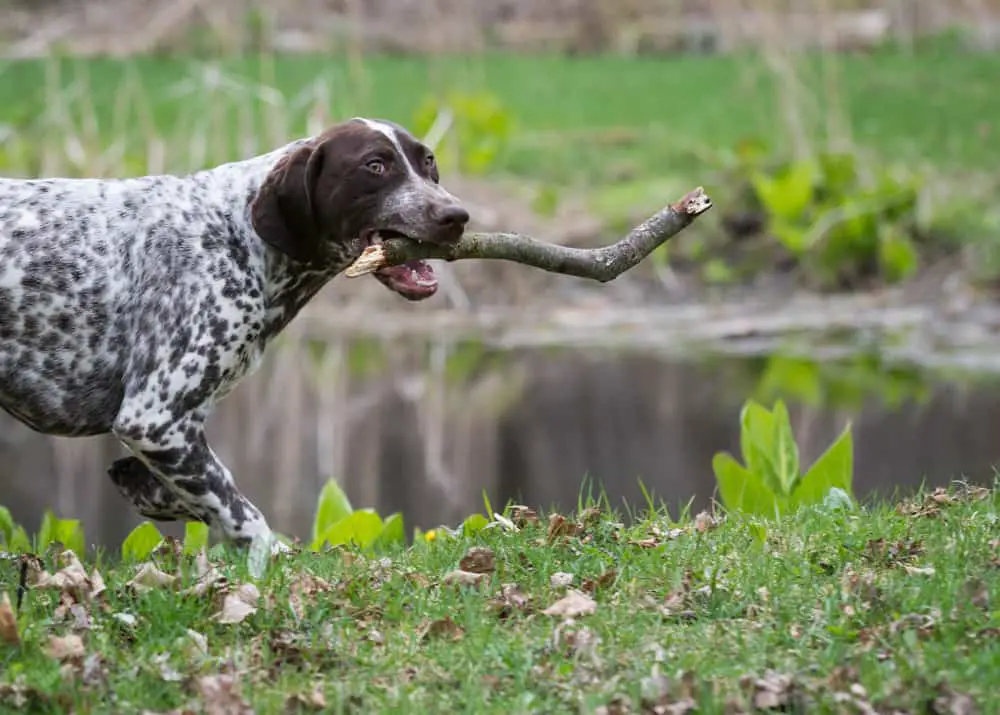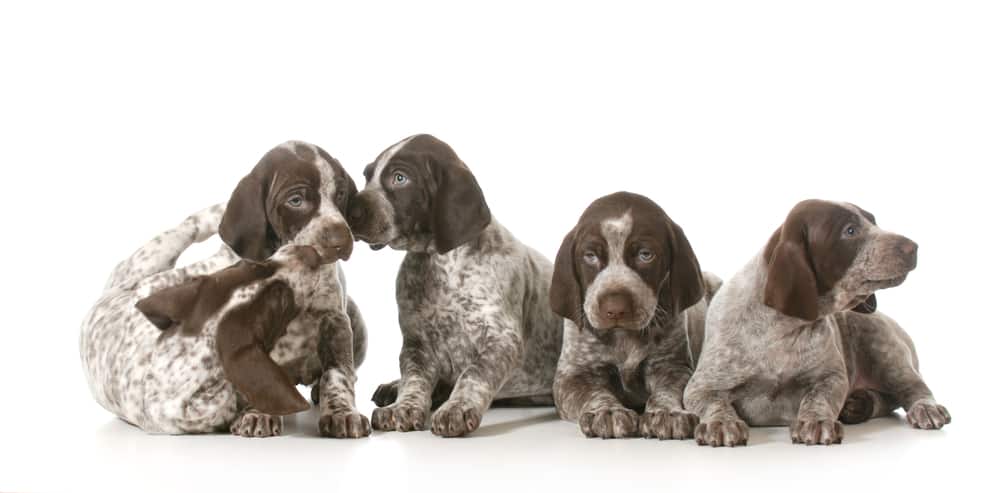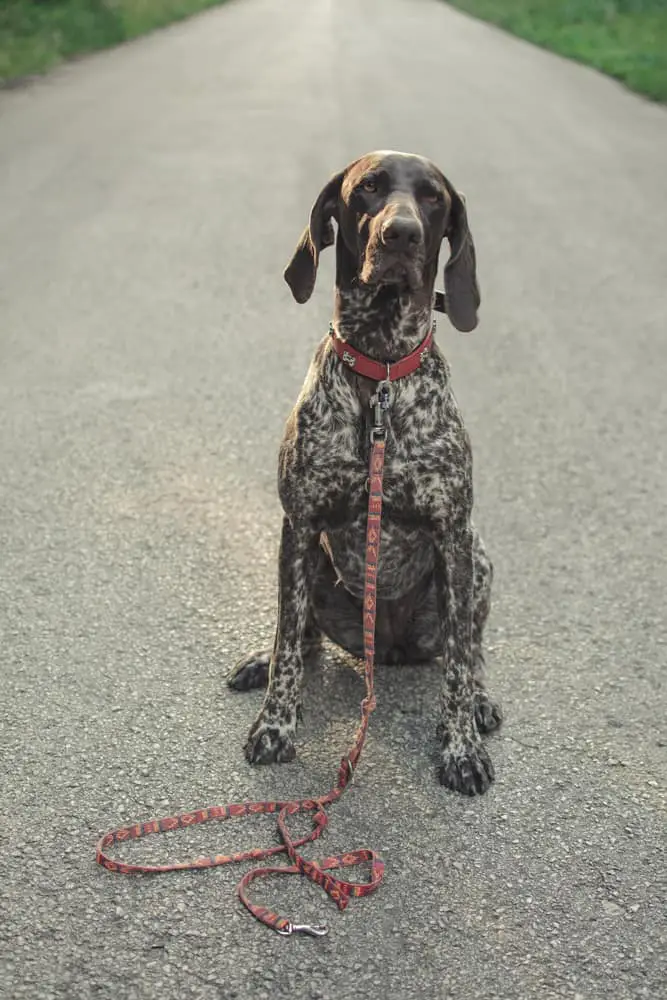Complete Guide To The German Shorthaired Pointer: Care, Feeding, Exercise and More
German Shorthaired Pointers (GSPs) are athletic sporting dogs and devoted family friends. Built for endurance, agility and speed, they’re inexhaustible people pleasers with a gentle spirit and a need for adventure. Don’t leave home without them.
As a practicing veterinarian with over 20 years experience, I’ve seen many, many GSPs over that time and have an excellent understanding of this breed. The following information is based on that experience as well as my discussions with dozens of GSP owners.

Table of Contents
How Big Do German Shorthaired Pointers Get?
German Shorthaired Pointers are medium-sized dogs averaging 45–70 pounds and standing 21 to 25 inches at the shoulder. Their powerful chests and muscular legs give them a square, symmetrical build.
What Do The Coats Of GSPs Look Like?
Coats are short, but not thin, with a coarse, sturdy texture. Their tails are docked at birth to 60-percent of their length — brown eyes are almond-shaped and wide-set.
Colors include:
• Black
• Black and white
• Liver
• Liver and white
• Liver Roan
Only liver and liver and white are approved by the American Kennel Club. Black and black and white dogs are accepted in other countries. An all-white coat and other hues are a disqualification for shows.
What Other Breeds Do GSPs Look Like?
German Shorthaired Pointers may be mistaken for Dalmatians and German Longhaired Pointers, a similar but separate breed.
What Is The Personality Of A German Shorthaired Pointer?
German Shorthaired Pointers are energetic but not jumpy. Intelligent and well-mannered, they thrive in tight-knit social groups and are excellent companions for active families with children.
Excitable as puppies, they need plenty of exercise, prompt training and early socialization to manage their youthful exuberance — good behavior is taught, not innate. A bored German Shorthaired Pointer can be destructive — they’d sooner chew on the sofa than sit on it, so keep them busy with toys, walks and games.
Happiest in outdoor settings, German Shorthaired Pointers were bred to hunt and are prone to chase. Their instincts for prey, including birds and squirrels, are razor-sharp, so city dogs are safest in a secure area with supervision.
What Kind Of Grooming Does A German Shorthaired Pointer Need?
German Shorthaired Pointers shed year-round and seasonally. But unlike other short-haired breeds, their coarse hairs are more challenging to remove from carpets, fabric and furniture, so an ounce of prevention is worth a pound of cure. Grooming is straightforward but essential.
Brush them every few days with a soft-bristled brush or grooming mitt to remove dead hair and distribute skin oil — a healthier coat is less likely to shed excessively. Frequent bathing isn’t necessary, but a scrub every few months with a skin-conditioning shampoo may tame hair loss.
German Shorthaired Pointers that hunt and retrieve waterfowl should be rinsed and dried after a dip in water of unknown quality. Despite a water-resistant coat — frequent exposure to moisture can cause irritation, yeast infections and unpleasant skin odors. Regular ear cleaning with a pH-balancing solution keeps microorganisms in check.
Outdoor activity helps keep toenails naturally short, but check them every two weeks — overgrown nails are prone to painful snags in thick brush.
What Is The Best Food For A German Shorthaired Pointer?
If you have a GSP puppy that is so hyperactive that you can’t keep weight on them, feeding a normal puppy food would be recommended. If you can consistently see the ribs sticking out on your GSP puppy, this is what you’ll want to do. You also may need to feed them more than what’s recommended as GSPs tend to be a lot more active than many other breeds.

Some might advocate a large-breed puppy food for some of the larger GSPs, but my experience is that most of these dogs struggle to keep their weight on due to how much they burn through exercise throughout the day.
Best Puppy Food For German Shorthaired Pointers:
Best Adult Food For German Shorthaired Pointers:
If you have an adult GSP that is so active that is also has a tough time keeping weight on (I think specifically of my hunting-caliber GSPs that always come into the practice looking emaciated because they never stop running), consider keeping them on puppy food and even supplementing their diet with puppy canned food as well (stick with the brand you’re already using for the dry food as this will hopefully limit stomach upset).
Please don’t listen to the folks at the pet store trying to convince you to buy a grain-free diet for your dog. There’s zero science behind that and vets are actually seeing diseases now related to feeding grain-free foods.
How Much Exercise Do German Shorthaired Pointers Need?
This breed has one of the highest exercise requirements of any breed in the world. They’re natural field dogs that want to be outside running and exploring. If you plan on owning a GSP, plan on providing a lot of exercise.

Ways To Exercise A GSP Include:
- Frequent, LONG walks and hikes over varying terrain
- Wearing a weighted vest (only for younger, healthier dogs with no orthopedic issues)
- Dog Parks
- Swimming
- Field Trials
- Agility
- Other organized dog activities such as dock diving, obedience trials, and coursing ability tests (CAT).
How Long Do German Shorthaired Pointers Live?
10-12 years based on information provided by the AKC
What Health Concerns Do German Shorthaired Pointer Have?
In my experience, GSPs tend to visit my office more than other breeds primarily because of how active they and how much trouble they inevitably get in as a result. The most common health issues seen in GSPs are:
- Lacerations/Trauma
- Hip Dysplasia
- Elbow Dysplasia
- ACL Tears
- Arthritis
- Heart Disease
- Heartworm Disease
- Corneal Ulcers
Where Can I Find a German Shorthaired Pointer?
If you’re looking for a working GSP, contacting a local hunting club is a great way to get started. They should have a list of breeders that routinely produce the best dog.
Otherwise, I would first start with the breeder list from the German Shorthaired Pointer Club Of America.
Also do a search for local breed clubs that also may be able to point you to local breeders that are reputable.
Are you looking for a rescue instead of a puppy? Good for you! Check out the National German Shorthaired Pointer Rescue!
Where To Find More Information About German Shorthaired Pointers
German Shorthaired Pointer Club of America
Interesting Facts about German Shorthaired Pointers
German Shorthaired Pointers don’t have the breed recognition of the Poodle or Labrador Retriever, but they have an intriguing story.
Did you know?
• They Have an Illustrious Pedigree
Breeders spent decades perfecting the German Shorthaired Pointer with the help of royal hunting enthusiasts. Prince Albrecht zu Solms-Braunfels of the Royal House of Hanover was a key proponent of the project, garnering support for their development from fellow nobility and sportsmen alike. Perfected in the 1800s, German Shorthaired Pointers remain competitive hunting champions.
• Pointers Are Named for Their Stance
Owners may not notice it in non-hunting dogs, but pointers are named for the stance they take when they locate prey. Their lowered heads, steady gaze and a lifted front paw are a clear signal they’re ready to give chase.
• They’re Prizewinners
German Shorthaired Pointers use their hunting instincts to navigate obstacle courses. They excel in agility tournaments, winning at least eight AKC Preferred Agility Champion titles since 1978. Three examples have won Best in Show at Westminster — the most recent was CJ, a stunning 3-year-old from California in 2016.
• German Shorthaired Pointers are Surprisingly Popular
Beating out perennial favorites, including Boxers and Shih Tzus, German Shorthaired Pointers ranked 9th on the AKC’s list of most popular dog breeds for 2020.
• They’re Camera-Shy
German Shorthaired Pointers don’t see much screen time — they’re notoriously absent in films — but they’re featured in Robert B. Parker’s popular Spenser book series, and in Mel Ellis’s novel, “Run, Rainey, Run.” Celebrities, including Ben Stein and Christy Turlington, however, have owned them.
• Docked Tails are Uniquely American
Prohibited in Europe, only puppies born in the United States have their tails docked.
• They’re Relatively New in the United States
The first German Shorthaired Pointers arrived in Montana in 1925. The AKC recognized the breed in 1930, a near-record time due, in part, to their impressive history.
• German Shorthaired Pointers are More Than Just Hunters
Loyal and fearless, German Shorthaired Pointers are dedicated protectors. Their trainability and lack of aggression would seemingly make them good candidates for service dog training, but they’re typically too energetic. Their sensitive noses are better suited for drug sniffing and search and rescue work.
